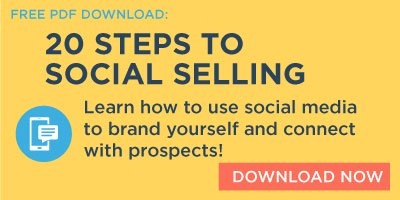-253741-edited.jpg?width=800&name=american-black-blue-1065704%20(1)-253741-edited.jpg) In an ever-changing sales landscape, maintaining a healthy personal brand on social media has become a necessary tool for sales professionals to build and maintain relationships with prospects. According to a Forrester Consulting study, Social Selling: A New B2B Imperative, “49% of B2B enterprises have developed a formal social selling program, and 28 percent are in the process of doing so.”
In an ever-changing sales landscape, maintaining a healthy personal brand on social media has become a necessary tool for sales professionals to build and maintain relationships with prospects. According to a Forrester Consulting study, Social Selling: A New B2B Imperative, “49% of B2B enterprises have developed a formal social selling program, and 28 percent are in the process of doing so.”
Even though using social media to sell has been widely adopted in many industries, our 2019 Media Sales Report found that only 12% of sales managers said their salespeople are using social media effectively to set appointments with prospects.
If you aren’t utilizing social selling as part of your sales strategy, you could be losing sales to more social-savvy salespeople.
 Hootsuite defines social selling as the art of using social networks to locate and build genuine relationships with buyers which can help you gather market insights, warm up leads, build a better buying experience, and ultimately generate sales.
Hootsuite defines social selling as the art of using social networks to locate and build genuine relationships with buyers which can help you gather market insights, warm up leads, build a better buying experience, and ultimately generate sales.
Hubspot states that “it’s a crucial way for successful sales teams to communicate with their prospects,” and defines it in under 100 words, “Social selling is when salespeople use social media to interact directly with their prospects. Salespeople will provide value by answering prospect questions and offering thoughtful content until the prospect is ready to buy.”
With more people than ever heading online to build an opinion and educate themselves on services and products before purchasing, it’s vital that salespeople have a strong, professional presence and nurture relationships with prospects in the social space.
Social Media Best Practices for Salespeople
1. Listen
Your customers and prospects are telling you exactly what they want, need or desire. You have a plethora of information at your fingertips. You just have to stop and strategically listen. Utilize this free information to learn and discover, then implement what you learn to your sales strategy and communication efforts. Use monitor and search tools to listen to the digital conversations happening on social media.
2. Engage
Don’t be a robot and automate likes and comments. Be authentic and remember that the purpose of social selling is to build relationships. Follow other thought leaders or community members. Seek profiles that relate to your target audience and connect with potential prospects. Set time aside to monitor feeds and engage with other people’s content and social interactions.
3. Provide Value
At the right place. At the right time. Don’t be too "sales-y." Educate and provide value with relevant content. Identifying your target persona to understand what they want is key to providing valuable content that would encourage engagement and interaction.
4. Pick the Right Channels
LinkedIn, Facebook, Twitter, and Instagram are the most popular social channels for social selling, but that doesn’t mean you need to do all of them or just do these. If your audience is on SnapChat, explore that. If your audience is not on Twitter, don’t waste your time creating content on a channel where your target audience won’t see it.
Our 2019 Media Sales Report found that 72% of media salespeople rarely use LinkedIn (0-5%) to connect with prospects, and out of these, roughly 1 out of 3 (32%), do not use LinkedIn at all. And, 40% of salespeople say they never use other types of social media to connect with prospects and clients. More than 3 out of 4 (78%) use it rarely or never, from 0-5% of the time.
5. Complete Your Profile
Your profile might be the first contact you ever have with a prospect. Ensure it’s complete with your full (real) name, a professional photo of you (not your dog or your favorite meal), brief bio and any other areas that tell your story. Social selling is about relationships, and relationships can’t be built if you’re hiding behind a sushi photo or a blank ‘About Me’ section.
6. Be Available
Since social selling is about building relationships, ensure people can reach you! Clearly communicate various communication channels you can be reached, which will depend on the social channel and what links or sections are available for contact information.
7. Connect
If you do all of this work and you don’t actually connect, then you’ve wasted time. The leads won’t just come running to you (well they might, but that normally happens after some hard, consistent work), so send an invitation to connect, make an endorsement, or send a personal message.
8. Join and Participate
LinkedIn provides a handful of effective tools for salespeople, and one of these is LinkedIn groups. Research groups related to your target audience or industry, join, and contribute to the conversation with relevant and educational content, tips or conversation. Don’t hold back. One way that you can share your expertise is by commenting on threads and linking to a relevant thought-leader blog post you wrote for more information.
9. Get the Details
Connecting on social media is great. But connecting on other channels to reach them directly via email or phone could enhance that connection and grow that relationship. There are tools that connect the information from social media with contact information to help salespeople reach their prospects on the best channel.
10. Don’t Pitch
As salespeople, we can get in the zone which could lead to ‘salesy’ social posts. Remember we are building relationships with social selling. This is not the place and likely not the time to present a solution or pitch a product. How could you possibly know enough about their desired business results to make a solid recommendation? Save the product pitch to follow a thorough needs analysis where your advice and consult will hold more weight and help to develop a stronger business relationship.
Remember that the goal of social selling is not to get a sale on first contact. It exists to build meaningful relationships. Utilize these best practices to gain insight on your target audience, nurture leads, and ultimately generate sales. You might not be the social-savvy salesperson on the first try. Take some time to listen on social platforms before you dive in head first. It’s time to leave old school selling on the table and adopt new school selling techniques to become a superstar salesperson and sell differently.




